
Delosperma, perennial ice plant: planting and growing
Contents
Deslosperma in a nutshell
- Essential groundcover succulent plant for dry gardens requiring no watering
- Flowers continuously from June to first frosts, providing 5 to 6 months of flowers
- Provides abundant, very colourful flowering in pink-violet, orange or yellow
- Loves sun, copes well with drought and is hardy down to −8 °C in well-drained soil
- Brightens rockeries and dry banks, crowns low walls and cascades from hanging baskets or containers with no maintenance
A word from our expert
Delosperma, perennial purslane or Delosperma ficoïde is a perennial groundcover plant, still too little-known, notable for its long, brilliant flowering and its vigorous growth.
It forms cushions with succulent leaves completely covered with large flowers from June to autumn.
If most widespread species is Delosperma cooperi, it declinates into superb cultivars with bright colours and into new must-have varieties such as ‘Wheels Of Wonders’.
Red Delosperma, white Delosperma, orange Delosperma cooperi or yellow Delosperma, all these perennial purslanes establish easily, require no maintenance and are an excellent alternative to short grass meadow in awkward, neglected corners of garden.
It thrives in dry conditions, in sun in very well-drained soil. Semi-hardy, it is best grown in a pot in regions where temperatures frequently fall below -8°C.
It spreads its carpets of flowers in rockeries, on dry banks, over low walls, in pots and hanging baskets.
Discover our collection of Delosperma or perennial purslane, this groundcover resistant to drought and salt spray, essential in your summer compositions.
Description and botany
Botanical data
- Latin name Delosperma
- Family Aizoaceae
- Common name Perennial ice plant, Perennial ficoid
- Flowering June to September
- Height 10 to 15 cm
- Sun exposure Sun
- Soil type Stony, Calcareous, well-drained
- Hardiness -8°C to -10°C
Delosperma, perennial ice plant or perennial ficoid, is a succulent plant belonging to family Aizoaceae, native to rocky cliffs and broken plains of South Africa, East Africa and Madagascar. Genus includes more than 150 species of bushes and mat-forming perennials but fewer than ten are commonly offered in cultivation. Delosperma cooperi, or Cooper’s ice plant, is best known and most widespread species.
You will often encounter the Delosperma hybrids of the new ‘Wheels of Wonder’ series, notable for their flowers twice the size of the type, available in a range of six vivid, radiant colours. Less frequently seen are Delosperma crassuloides with white flowers or Delosperma echinatum, two tender species best reserved for Mediterranean climates.
Delosperma forms a small low clump with erect, prostrate or even trailing habit, not exceeding 10 to 15 cm in height. Its very brittle stems root and ramify easily on contact with soil to spread year after year, quickly carpeting an area up to 1 m wide if conditions suit. It develops into a very dense groundcover and can remain in place for many years.
Its succulent foliage clustered on these creeping stems is evergreen. Sessile, very fleshy and pointed, the leaves measure 0.5 to 5 cm long, are triangular to cylindrical and appear in opposite pairs. Their epidermis is verrucate, covered with minute papillae that protect it from scorching sun. Its succulent leaves store water and act as reserves for the plant. They occur in every shade of green, from pale to glaucous bluish-green, and some show white highlights, hence English nickname ‘Ice Plant’.
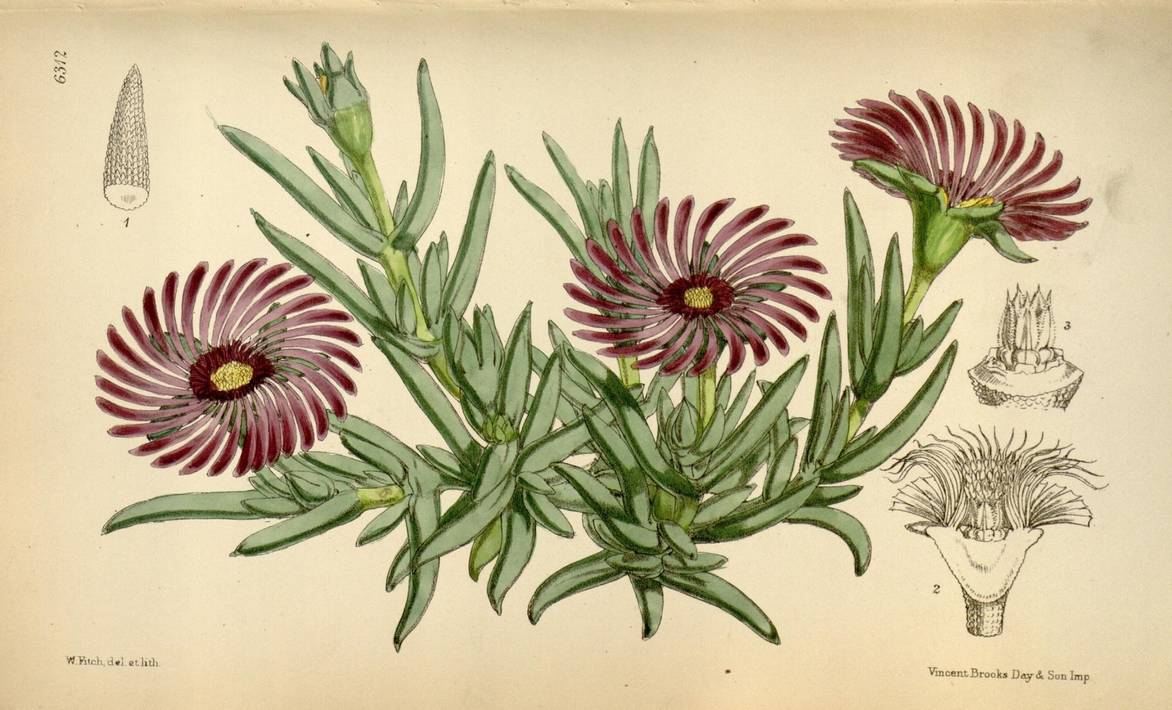
Delosperma cooperi – botanical illustration
Delosperma produces an abundant, bright and very colourful display that lasts from June until the frosts. Star-shaped flowers 0.5 to 5 cm in diameter, in solitary heads or gathered in fairly loose cymes at the tips of the stems, strew the foliage so spectacularly that they almost entirely cover it, especially in the ‘Wheels of Wonder’ series, which bears flowers twice the size of the type.
The corollas, daisy-like, are formed of numerous fine, shiny ligules radiating around a golden-yellow, white or pink centre that contains a multitude of stamens. Pure golden-yellow, mauve, lilac, carmine red, white or bright orange, the colours are so vivid and striking they look painted and are visible from a distance. Some are bicoloured.
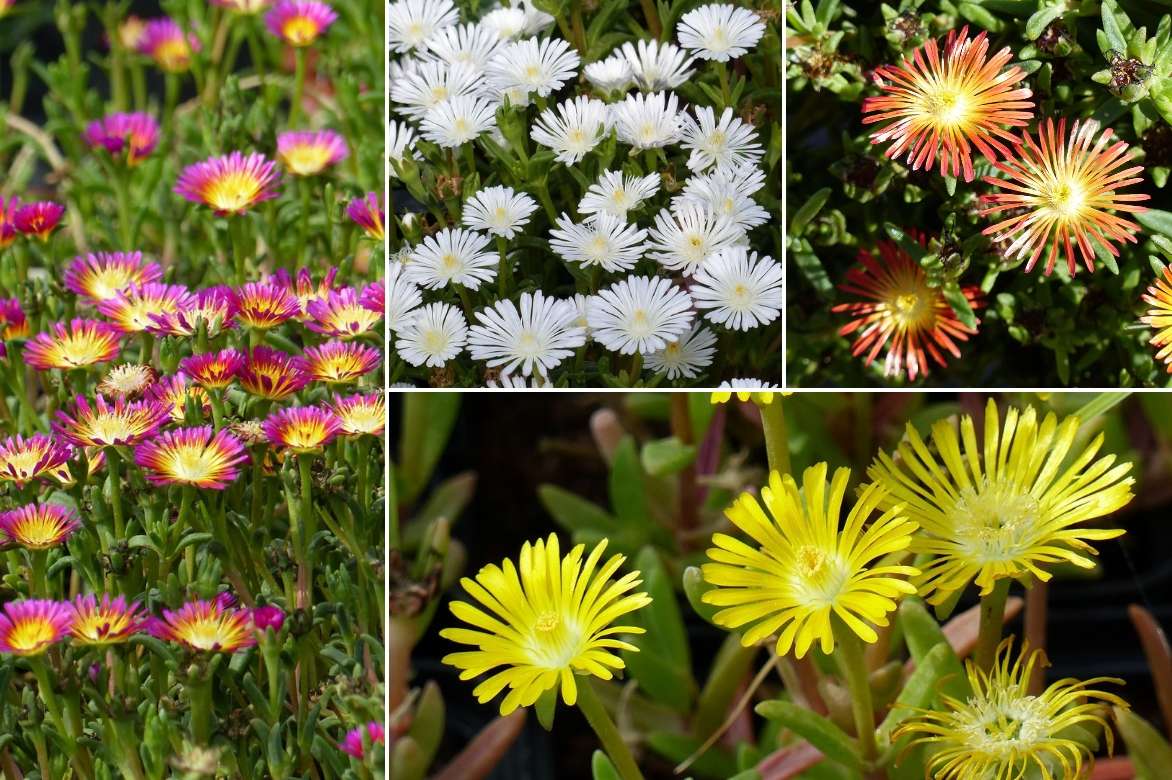
Several flower colours: Delosperma Wheels of Wonder Hot Pink, Delosperma Wheels of Wonder White, Delosperma Wheels of Wonder Fire, Delosperma Wheels of Wonder Golden
They open at sunrise and close again at dusk. Free-flowering, they continue until early autumn, attracting butterflies to your garden.
Half-hardy, the perennial ice plant is best suited to Mediterranean climates, coastal gardens and mild regions where severe frosts do not occur. In cold climates and regions with harsh, wet winters, it is preferable to grow it in tubs or pots and move indoors to a frost-free conservatory or greenhouse for winter, if temperatures fall below -8°C to -10°C.

Succulent foliage of Delosperma (photo Charlie Gaddy-Flickr)
To thrive, it needs a very sunny position in very well-drained soil, even dry, rocky ground, and tolerates sandy seaside soils. From its origins it has retained very good drought resistance.
Plant at edge of a dry border, in a rock garden, in pots or planters, or on a well-exposed bank.
Main species and varieties
While Delosperma cooperi or Cooper’s ice plant with mauve flowers is the most common species in our gardens, new ‘Wheels of Wonder’ varieties with large declinate flowers in vivid, varied colours are now available.

Delosperma cooperi
- Flowering time July to October
- Height at maturity 10 cm

Delosperma Wheels of Wonder Golden - Ice Plant
- Flowering time July to October
- Height at maturity 15 cm

Delosperma Wheels of Wonder Hot Pink - Ice Plant
- Flowering time July to October
- Height at maturity 15 cm

Delosperma Wheels of Wonder Orange - Ice Plant
- Flowering time July to October
- Height at maturity 15 cm

Ice Plant Stardust Seeds - Delosperma floribundum
- Flowering time June to November
- Height at maturity 15 cm
Discover other Delosperma
View all →Available in 0 sizes
Available in 2 sizes
Available in 2 sizes
Available in 2 sizes
Available in 2 sizes
Available in 1 sizes
Available in 2 sizes
Available in 1 sizes
Available in 2 sizes
Available in 1 sizes
Planting
Where to plant Delosperma or perennial purslane
Delosperma or perennial purslane is a plant of warm, dry climate. The Delosperma or perennial purslane has fairly moderate hardiness (tolerates frosts down to -8 to -10°C in very well-drained soil), so planting is best reserved for regions where winters are not too severe.
Some species are very tender (Delosperma echinatum) and cope poorly with temperatures below 0°C, so they can only be grown in gardens of southern France. In cold, especially damp, grow it preferably in a pot, sheltering it over winter in a conservatory and bringing it out in spring.
Resistant to drought, wind and sea spray, it is a perennial well adapted to Mediterranean climate and coastal gardens.
It needs full sun and warmth to flower well in very well-drained, rather poor, dry, even stony soil: it is the dry rock-garden plant par excellence, perfectly suited to poor soils and growing as long as it finds a little substrate. It does well in sandy soils. Conversely, heavy, waterlogged soils and winter freezing rains are fatal.
It is indispensable as groundcover in seaside and dry gardens, in arid rockeries, between stones, on paving slabs of a path, on a bank, above a low wall or even in a trough, a hanging basket or a pot to bring indoors for winter, if necessary.
When to plant Delosperma or perennial purslane
Plant the perennial purslane in spring, from February to April so it has time to root well before winter, or from August to October outside periods of frost or severe drought.
How to plant Delospermas or perennial purslanes
In open ground
Allow about 5 to 6 young plants per square metre, spaced 30 cm apart for a beautiful tapetum of flowers with succulent leaves.
In heavy soil, add coarse sand or gravel to bottom of hole to improve drainage.
- Soak the rootball before planting
- Dig a hole 2 to 3 times wider than the bucket
- Remove from bucket and position the rootball
- Backfill, adding a little river sand to garden soil
- Firm lightly
- Water until established
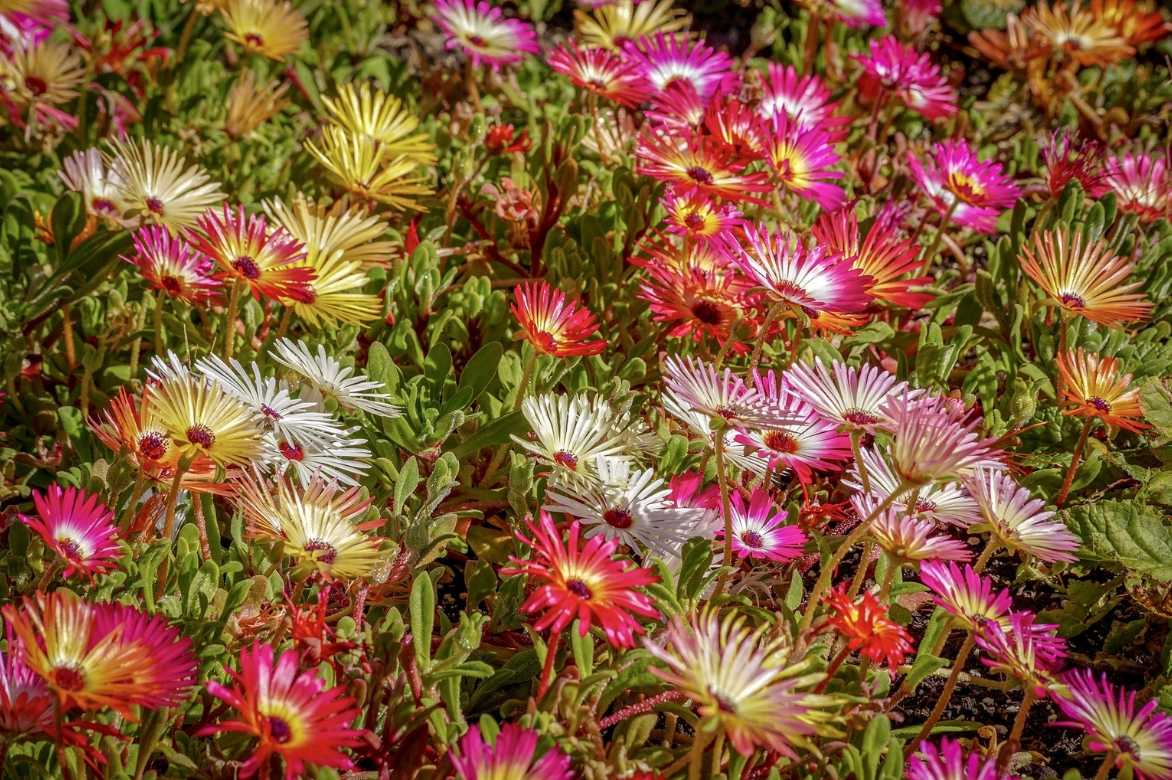
In a pot
Substrate must be light and very well drained to avoid stagnant moisture around roots. Install Delosperma in full sun in a pot at least 30 cm in diameter.
- Lay a good drainage layer (gravel or clay balls)
- Plant in a mix of potting compost, garden soil and gravel
- Shelter from frost and winter rains by keeping in a greenhouse
- Water regularly but sparingly
→ Learn more about growing Delosperma in a pot
When and how to sow perennial purslane seeds
Sowing of Delosperma or ice plant seeds is carried out in seed trays in March or outdoors in April–May.
In seed trays
- At 18–21 °C, sow thinly on surface of moist compost in a seed tray
- Do not cover seeds and place in light, keeping moist until germination, which takes 10–21 days
- As soon as seedlings are sturdy enough, pot on into 7 cm buckets
- Plant in May in open ground, spacing young plants about 25 cm apart once risk of frost has passed, or in pots or window boxes
Outdoors
- Sow the perennial ice plant seeds by broadcasting on light soil amended with coarse sand
- Cover with a thin layer of compost
- Firm down
- Water
- Thin seedlings to leave about 25 cm between young plants
Care, pruning and maintenance of Delosperma
Undemanding, perennial ice plant grows unaided without maintenance, braving drought provided conditions suit: a sunny spot in well-draining soil with no standing water at its base. Once established, Delosperma is disease-resistant as it is only troubled by excess moisture.
It is a succulent capable of storing large amounts of water.
Water only during first year after planting; once established, it will rely on rain, perfect for a no-watering garden!
Remove faded flowers to encourage renewal.
In autumn, prevent plant from being covered by dead leaves, which could cause its foliage — very sensitive to excess moisture — to rot.
Every 2 to 3 years, in spring or autumn, divide the stump to rejuvenate the plant.
In a pot, water only once a week, keep dry in winter. Optionally apply liquid fertiliser in spring to encourage abundant flowering.
When and how to prune delosperma
The perennial ice plant is a groundcover that can be invasive. No pruning is really necessary; the only constraint may be to limit its spread by removing layering roots in early spring: cut them with pruning shear.
Remove any parts damaged by rain.
Multiplication
If sowing is possible, easiest option is to take stem cuttings in summer. Division is also possible in autumn but more delicate because of fragility of Delosperma stems.
Propagation by cuttings of Delosperma
- Between July and September, take a stem with adventive roots
- Leave it to dry for a day or two
- Plant in small pots half-filled with garden soil and sand and a little compost
- Cover with sand
- Firm down
- Water cuttings regularly
- Overwinter them frost-free under cold frame
- Plant out into open ground the following spring when soil is well warmed and all risk of frost has passed
Uses and companion planting in the garden
Perennial purslane is indispensable in dry rockeries and in holiday gardens without irrigation, where it forms colourful flowering tapetum.
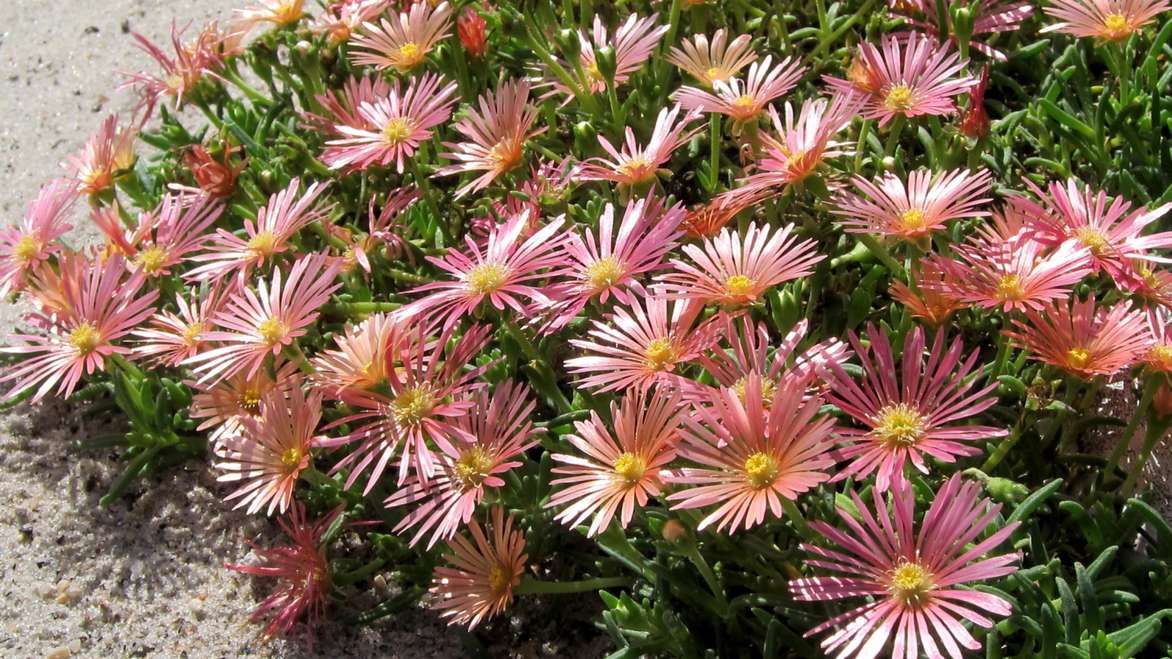
Delosperma ‘Kelaidis’ in dry garden (photo cultivar413-Flickr)
When planted en masse, it provides contrast with its vibrant hues, in monochrome or variegated form.
Easy to combine with plants sharing same needs: sun and dry soil.
At edge of a sunny border, perfect in company of a few yarrows, at base of valerians, poppies or helianthemums. At edge of a mineral bed, it will add a small touch of colour, tucked among grasses.
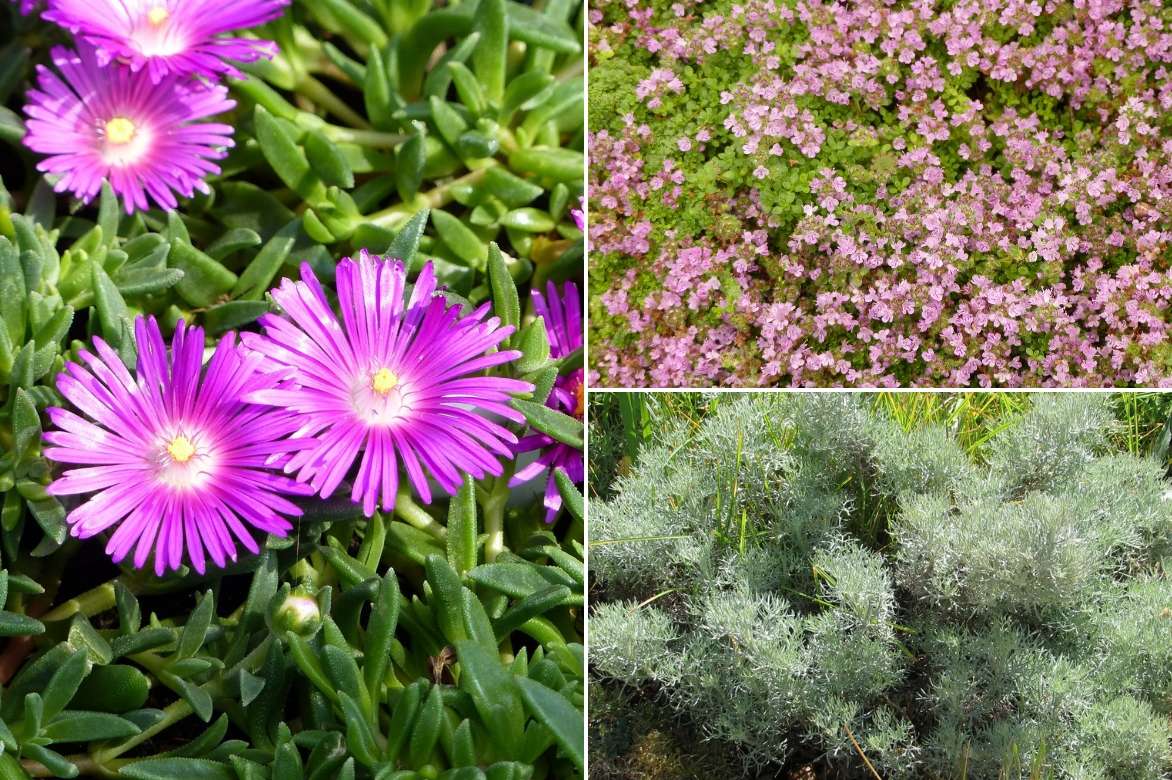
An idea for a pairing in a sunny, dry situation: Delosperma cooperi, Thymus serpyllum ‘Minimus’ and Artemisia canescens (photo Peganum)
In a dry rockery, it thrives alongside other undemanding groundcover perennials ideal for covering large areas on poor, dry ground such as mouse ears, Sedums, Dianthus, wall bellflowers and Stachys.
→ Discover more ideas for pairing with Delosperma in our advice sheet!
Useful resources
- Discover our selection of 5 Delosperma with orange or yellow flowers ; 6 Delosperma with pink flowers
- Think about ground-cover perennials such as Delosperma, which will save you weeding!
- What to plant in a dry garden?
- Perennial purslane is essential in a low-maintenance garden; what are its companion plants?
- Discover 5 Mediterranean plants to brighten a balcony
- Subscribe!
- Contents































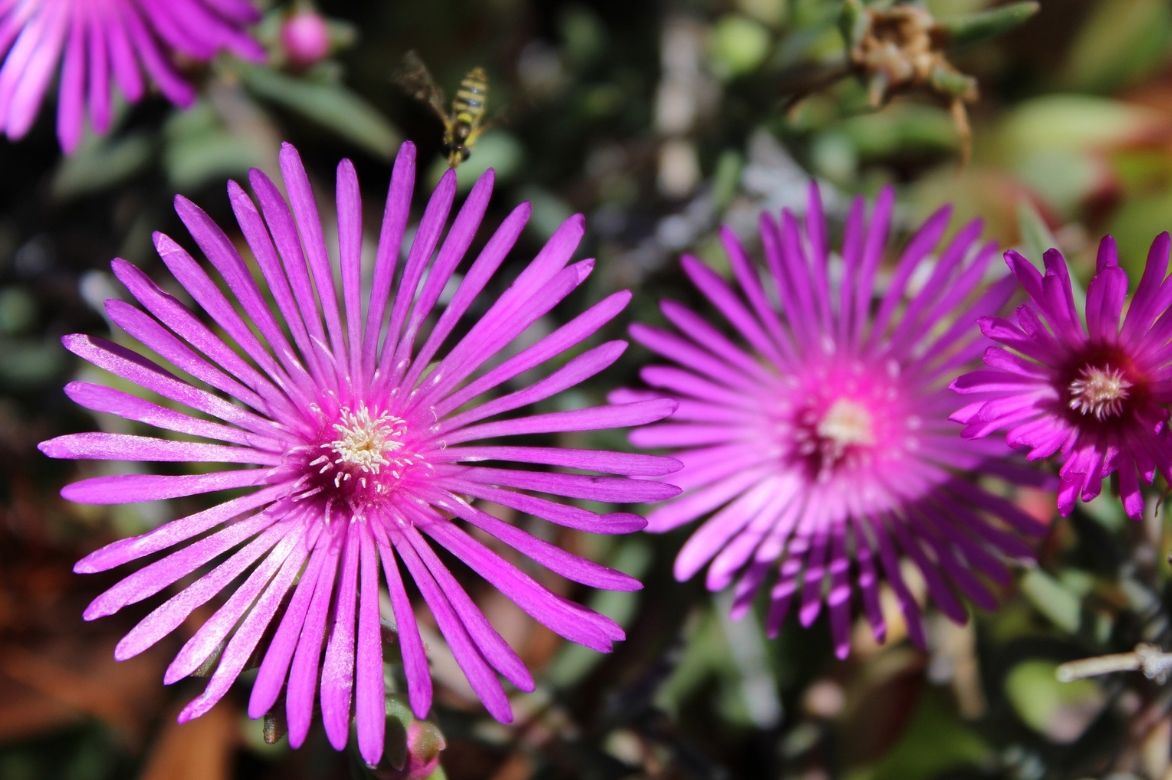











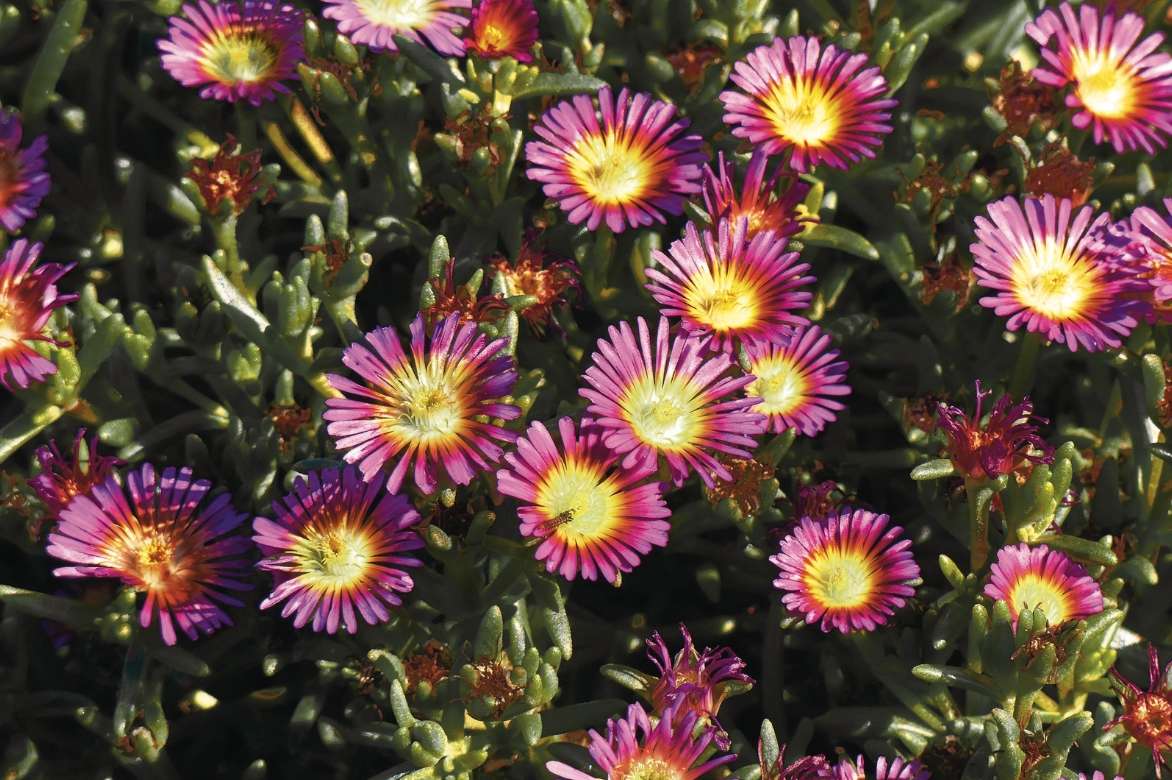
Comments